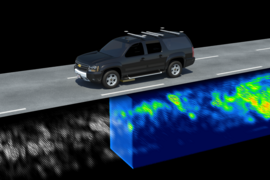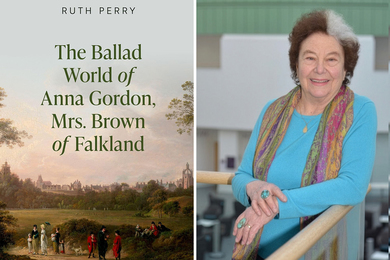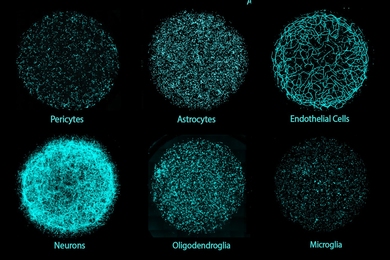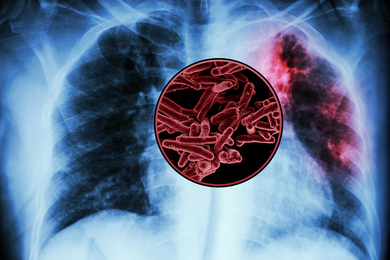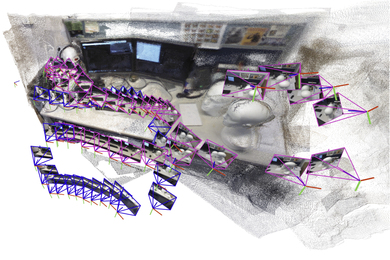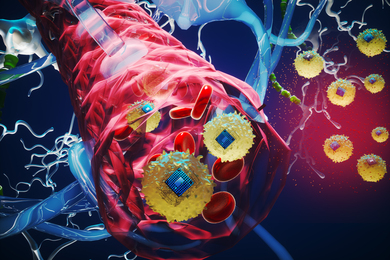Canine teams have long been considered the gold standard for finding concealed explosives. To validate this reputation, the U.S. Department of Homeland Security Science and Technology Directorate (DHS S&T) remains diligent in their pursuit of continuously improving canine performance as part of their public safety mission. With support from the DHS S&T, researchers at MIT Lincoln Laboratory have developed a new mass spectrometer that may help DHS S&T improve canine training standards and materials.
Currently, canines are taught to recognize odors that correspond to specific objects they are trained to locate. In this process, the strength of the training odor is assumed to be proportional to the mass of hidden explosive used with smaller threats presumed to produce weaker odors. However, this is a broadly accepted assumption that does not always prove to be true. As a result, future training methods that can record the strengths of the odors used will provide an added dimension to the tests — an important capability that is provided by Lincoln Laboratory's new spectrometer.
The mass spectrometer, roughly the size of a copy machine, can identify chemicals on the basis of their mass and charge after it ionizes the vapors given off from solids or liquids comprising a sample. A sample can be anything from a few drops of liquid to a piece of paper to a large explosive charge. The mass spectrometer can detect chemicals found in the liquid, on the paper, or within the explosive charge, and provide a data readout that displays what chemical vapors emanated from the sample. The spectrometer possesses two modes that can, in less than one second, detect a potential threat vapor at the parts-per-trillion, and sometimes even the parts-per-quadrillion level, a performance level that is thought to be comparable to canine performance.
Roderick Kunz, assistant leader of the laboratory's Chemical, Microsystem, and Nanoscale Technologies Group, and group staff members Ta-Hsuan Ong, Thomas Mendum, Geoffrey Geurtsen, Jude Kelley, and Alla Ostrinskaya developed this mass spectrometer to verify the canines’ responses to explosive materials. Because this instrument instantaneously detects vapor plumes produced from the training materials or aids (such as a treated piece of paper placed within a can), a trainer can be made aware of the scent produced during the test and thus has added information when deciding to reward the canines’ response to the odor. This can lead to more accurate and consistent behavioral reinforcement and, ultimately, better performing canines and a safer public.
“We have heard from canine handlers their desire to better understand the canine odor environment,” Kunz says. “This instrument provides that capability and, for the first time, allows the handler to experience what the canines themselves are experiencing. Creating the capability for handlers to know the true odor environment has the potential to be a powerful training tool for making handlers more ‘plume aware.’”
“One of the biggest challenges [in detecting vapors from explosive devices] is that many explosives have extremely low vapor pressure and the vapors are not detectable at room temperature by anything other than canines. Our challenge to Lincoln Laboratory was to devise a system that can validate the presence of odor without heating [the sample], which can degrade it, thus confirming that canines are detecting these substances at levels less than one part per trillion,” says Don Roberts, DHS S&T Explosives Detection Canine Program manager. “We now can validate with scientific certainty that the canine detection threshold is well below many of the commercially available explosive systems currently in use.”
Bomb-detecting canines are trained specifically for their jobs by specialists. Once the canines are deployed to agencies such as a public-transit police force, continued training known as maintenance training is provided throughout their deployment by the home agency. Maintenance training is typically performed on a set test course on which handlers plant training aids that emit vapor plumes from different explosive materials. The handlers are typically only aware of the most general information, which might consist of a simple layout indicating the locations of training aids on the course. The dogs then walk the course with the handlers and are tested to see how they react to the planted materials, during which the canines’ desired behavior is positively reinforced.
Sometimes, however, training aids degrade over time or are contaminated by other training aids if they are not stored properly, causing the association between the threat environment and the resulting odor environment to deviate from that expected by the handler. Before the development of this mass spectrometer, no method could corroborate the dogs’ decisions when they informed the handler of the presence or absence of explosives. With this instrument, the handlers can now provide more consistent maintenance training because they are able to test and verify the odor environment during training.
To demonstrate the value of the new instrument, the researchers used seven active-duty canines across two training events and compared their performance as determined by the threat object placement (i.e., the “ground truth”) with their performance as determined by the odor environment (i.e., the “plume truth”). By comparing these two performance metrics, the researchers were able to determine the odors eliciting the canines’ responses and correlate that information to training aid placement. If a handler placed a training aid on the course and the canine found it, this was counted as correct based on the threat environment criteria. When a non-threat “decoy” object had been inadvertently contaminated by an explosive trace, the handler failed to recognize what had elicited the canine response. However, the spectrometer was able to corroborate the canine response and provide the handler with information needed to respond to the behavior.
During these trials, the research team was also able to show that the canines’ performance varied with odor strength. This correlation showed that canine performance wasn’t only linked to the size of the object or training aid; thus, with the mass spectrometer, handlers now have an alternative method for performing evaluations based on vapor concentration rather than the just the object size.
The ability to know the true odor environment will create an improvement in the training process by allowing the handlers to correct the canines’ actions when they react to an inappropriate scent. It will also help the handlers learn how to improve their training aid storage and test administration methods, even after the Lincoln Laboratory mass spectrometer has moved on to assist other canine units.
“At present, the capability the spectrometer provides is limited to research applications because of its size and complexity,” Kunz says. “However, other laboratories are considering adapting it for tactical field use as a means to replace canines. Our feeling is that such a tool is better directed at improving the already best detectors in the world — canines.”
Ta-Hsuan Ong will present the laboratory’s work on the spectrometer at the 12th International Symposium on the Analysis and Detection of Explosives, which is being held Sept. 17-21 in Oxford, England.


